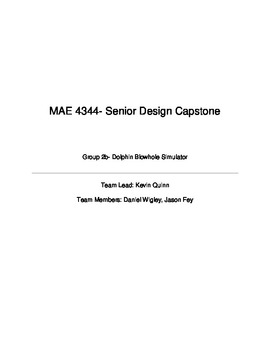| dc.contributor.author | Quinn, Kevin | |
| dc.contributor.author | Wigley, Daniel | |
| dc.contributor.author | Fey, Jason | |
| dc.date.accessioned | 2018-11-21T21:24:55Z | |
| dc.date.available | 2018-11-21T21:24:55Z | |
| dc.date.issued | 2018-04-30 | |
| dc.identifier | oksd_fey_HT_2018 | |
| dc.identifier.uri | https://hdl.handle.net/11244/302109 | |
| dc.description.abstract | The use of drones have been proposed for the collection of biological samples in marine mammals, specifically marine biologists need to obtain samples of dolphin "blow" from their blowhole discharge in the wild. These non-invasive techniques are needed to assess biological health such as reproductive and adrenal functions. While the techniques have been demonstrated on whales, dolphins have proven more difficult to obtain samples from due to their speed and apprehensiveness to typical quadcopter drone. Thus, quiet fixed wing vehicles are proposed. In order to assess the feasibility to capture a sample, a blowhole simulator is needed that mimics the intermittent outflow characteristics of the blowhole jet, including flow rate, jet velocity, height, and spread. | |
| dc.format | application/pdf | |
| dc.language | en_US | |
| dc.rights | Copyright is held by the author who has granted the Oklahoma State University Library the non-exclusive right to share this material in its institutional repository. Contact Digital Library Services at lib-dls@okstate.edu or 405-744-9161 for the permission policy on the use, reproduction or distribution of this material. | |
| dc.title | MAE 4344 - Senior design capstone: Group 2b - Dolphin blowhole simulator | |
| osu.filename | oksd_fey_HT_2018.pdf | |
| osu.accesstype | Open Access | |
| dc.type.genre | Honors Thesis | |
| dc.type.material | Text | |
| thesis.degree.discipline | Mechanical and Aerospace Engineering | |
| thesis.degree.grantor | Oklahoma State University | |
